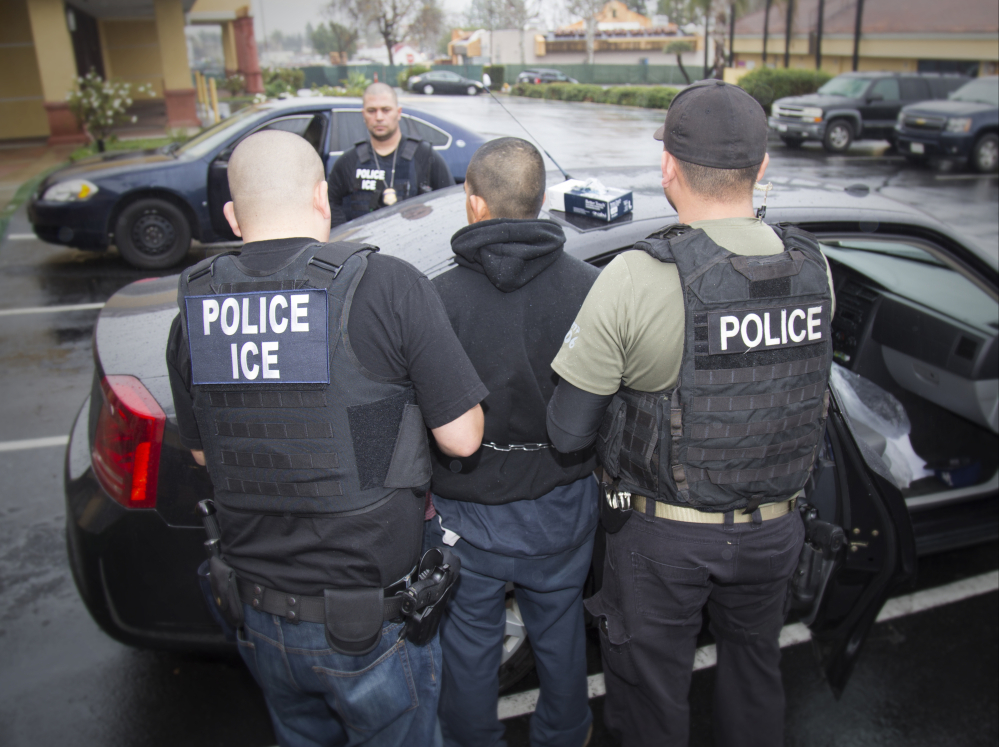Fear and panic have gripped America’s immigrant community as reports circulate that federal agents have become newly aggressive under President Trump, who campaigned for office with a vow to create a “deportation force.”
Federal officials insist they have not made fundamental changes in enforcement actions, and they deny stopping people randomly at checkpoints or conducting “sweeps” of locations where undocumented immigrants are common.
But anxiety among immigrants spiked this week after the Immigration and Customs Enforcement agency conducted a series of enforcement actions in large metropolitan areas. On Saturday, the agency announced that more than 200 people had been arrested this week in six states overseen by the Chicago office. That was in addition to more than 160 detained in the Los Angeles area, as well as arrests in New York, Atlanta and other cities.
Members of the Congressional Hispanic Congress on Saturday demanded an immediate meeting with Thomas Homan, the acting head of ICE.
“These raids have struck fear in the hearts of the immigrant community as many fear that Trump’s promised ‘deportation force’ is now in full-swing,” the lawmakers wrote in a letter to Homan.
What’s certain is that even if ICE and other officials say this is business as usual, many immigrants find more persuasive the words and actions of Trump, whose political rise was propelled by anti-immigrant rhetoric, a vow to build a wall on the Mexican border and the promise to deport 3 million criminal aliens.
The president roiled Washington two weeks ago with his surprise executive order banning travel to the U.S. from seven Muslim-majority countries and a halt in accepting refugees. That order was blocked by federal judges, and while Trump ponders whether to appeal the case to the Supreme Court, he has said he will craft other executive orders that will make America more secure.
On Jan. 25, five days after taking the oath of office, he issued an executive order titled “Enhancing Public Safety in the Interior of the United States.” Media attention focused on Trump’s call for an end to federal funds for “sanctuary cities,” communities which to varying degrees do not automatically hand over illegal immigrants who come to the attention of local law enforcement.
But the order also expanded the list of deportation priorities to include any noncitizen who is charged with a criminal offense of any kind or who is suspected of committing criminal acts, fraud or willful dishonesty while interacting with immigration officials, is the subject of a pending order of removal or has been previously deported and reentered the country. The order gave much broader leeway to ICE officers in deciding whether someone posed “a risk to public safety” and therefore could be detained.
For immigrant rights activists, the rules of engagement have clearly changed.
“Donald Trump has effectively created a way to deport individuals who have been accused, charged or convicted of anything from murder to jaywalking,” said Angelica Salas, executive director of the Coalition for Humane Immigrant Rights of Los Angeles. “And if you read the text of that executive order broadly, that applies to all noncitizens. I can tell you, the possibilities have made a lot of people here shudder.”
Entering the country illegally – what is technically known as entering the U.S. without inspection – is itself a misdemeanor. Anyone caught in possession of fake identification documents or who is not honest with immigration officials can also be charged with a crime.
Under President Obama, priority deportees included people who had been convicted of murder and other violent crimes as well as certain drug offenses and gang involvement. Obama’s policies called on ICE officials to avoid detaining, whenever possible, nursing mothers and those with serious medical conditions.
Fear of being detained or deported could lead many people to avoid going to work, school or to public places in coming days, Salas said.
Send questions/comments to the editors.




Success. Please wait for the page to reload. If the page does not reload within 5 seconds, please refresh the page.
Enter your email and password to access comments.
Hi, to comment on stories you must . This profile is in addition to your subscription and website login.
Already have a commenting profile? .
Invalid username/password.
Please check your email to confirm and complete your registration.
Only subscribers are eligible to post comments. Please subscribe or login first for digital access. Here’s why.
Use the form below to reset your password. When you've submitted your account email, we will send an email with a reset code.